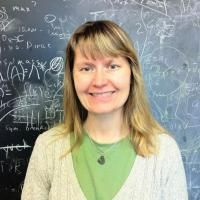Atmospheric neutrino oscillation analysis with subleading effects in Super-Kamiokande I, II, and III
Date
2010-05-20
Journal Title
Journal ISSN
Volume Title
Repository Usage Stats
views
downloads
Citation Stats
Abstract
We present a search for nonzero θ13 and deviations of sin2θ23 from 0.5 in the oscillations of atmospheric neutrino data from Super-Kamiokande I, II, and III. No distortions of the neutrino flux consistent with nonzero θ13 are found and both neutrino mass hierarchy hypotheses are in agreement with the data. The data are best fit at Δm2=2.1×10-3eV2, sin2θ13=0.0, and sin2θ23=0.5. In the normal (inverted) hierarchy θ13 and Δm2 are constrained at the one-dimensional 90% C.L. to sin2θ13<0.04(0.09) and 1.9(1.7)×10 -3<Δm2<2.6(2.7)×10-3eV2. The atmospheric mixing angle is within 0.407≤sin2θ23≤0.583 at 90% C.L. © 2010 The American Physical Society.
Type
Department
Description
Provenance
Subjects
Citation
Permalink
Published Version (Please cite this version)
Publication Info
Wendell, R, C Ishihara, K Abe, Y Hayato, T Iida, M Ikeda, K Iyogi, J Kameda, et al. (2010). Atmospheric neutrino oscillation analysis with subleading effects in Super-Kamiokande I, II, and III. Physical Review D - Particles, Fields, Gravitation and Cosmology, 81(9). p. 92004. 10.1103/PhysRevD.81.092004 Retrieved from https://hdl.handle.net/10161/4274.
This is constructed from limited available data and may be imprecise. To cite this article, please review & use the official citation provided by the journal.
Collections
Scholars@Duke

Kate Scholberg
Prof. Scholberg's broad research interests include experimental elementary particle physics, astrophysics and cosmology. Her main specific interests are in neutrino physics: she studies neutrino oscillations with the Super-Kamiokande experiment, a giant underground water Cherenkov detector located in a mine in the Japanese Alps. Super-K was constructed to search for proton decay and to study neutrinos from the sun, from cosmic ray collisions in the atmosphere, and from supernovae. On Super-K, Prof. Scholberg's primary involvement is with the atmospheric neutrino data analysis, which in 1998 yielded the first convincing evidence for neutrino oscillation (implying the existence of non-zero neutrino mass).
One of the most important questions that we may be able to answer with neutrino oscillation experiments over the next couple of decades is the question of CP (charge conjugation-parity) violation in neutrinos. It's now well known that processes involving quarks violate CP symmetry; it's suspected that the same is true for leptons (such as neutrinos), but leptonic CP violation is as yet unobserved. We hope that understanding of CP violation, along with knowledge of the other neutrino parameters, may lead to insight into the question of the observed matter-antimatter asymmetry of the universe. The long-term program neutrino oscillation physics aims to answer these questions.
The next steps in neutrino oscillation research involve artificial beams of neutrinos sent hundreds of kilometers from accelerator laboratories to underground detectors. The T2K ("Tokai to Kamioka") high-intensity beam experiment sends neutrinos 300 km from an accelerator at the J-PARC facility in Japan to Super-K, and is currently exploring unknown oscillation parameters. The DUNE (Deep Underground Neutrino Experiment) is a planned next-generation U.S.-based international experiment designed to observe neutrinos beamed from Fermilab to a large liquid argon detector at a new underground facility in South Dakota. One of Prof. Scholberg's particular interests on DUNE is the detector's sensitivity to the huge bursts of neutrinos from core-collapse supernovae.
Prof. Scholberg serves as spokesperson of COHERENT, a multi-detector experiment with the primary physics goal of measuring CEvNS (Coherent Elastic Neutrino Nucleus Scattering) using the high-intensity neutrinos produced by the Spallation Neutron Source at Oak Ridge National Laboratory in Tennessee. CEvNS was measured for the first time by the collaboration in 2017.
Prof. Scholberg was a co-founder of SNEWS, the SuperNova Early Warning System, an inter-experiment collaboration of detectors with Galactic supernova sensitivity. Neutrinos from a core collapse will precede the photon signal by hours; therefore coincident observation of a burst in several neutrino detectors will be a robust early warning of a visible supernova. The goals of SNEWS are to provide the astronomical community with a prompt alert of a Galactic core collapse, as well as to optimize global sensitivity to supernova neutrino physics.

Christopher Walter
I am a professor in the physics department studying particle physics and cosmology. I try to understand both the nature of the ghostly particles called neutrinos in giant detectors deep underground, and why the expansion of the universe is accelerating using telescopes on top of mountains. My background and training is originally in particle physics and I was part of the team that showed the sub-atomic particles called neutrinos have mass. The leader of our team, T. Kajita was co-awarded the 2015 Nobel Prize in Physics for this discovery which cited the work of our collaboration. I also began the effort in observational cosmology at Duke, joining the Vera C. Rubin Observatory, a giant telescope under construction in Chile designed to make a 10 year, three dimensional survey of the entire visible sky. Using the Rubin Observatory, we will focus on examining billions of galaxies, along with supernovae and other astronomical probes to try to determine the nature of the mysterious “Dark Energy” which is unaccountably causing the universe to pushed apart at a faster and faster rate.
Unless otherwise indicated, scholarly articles published by Duke faculty members are made available here with a CC-BY-NC (Creative Commons Attribution Non-Commercial) license, as enabled by the Duke Open Access Policy. If you wish to use the materials in ways not already permitted under CC-BY-NC, please consult the copyright owner. Other materials are made available here through the author’s grant of a non-exclusive license to make their work openly accessible.
